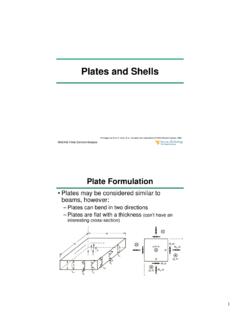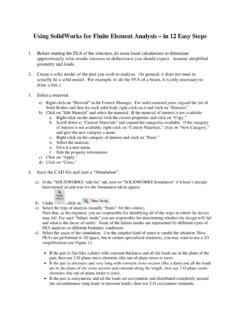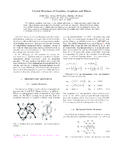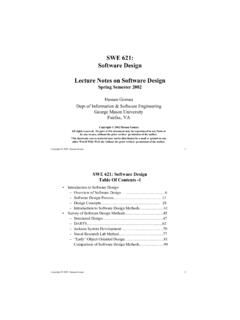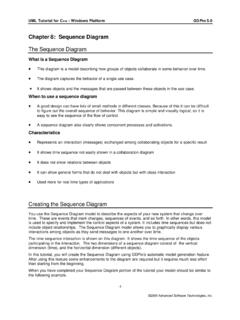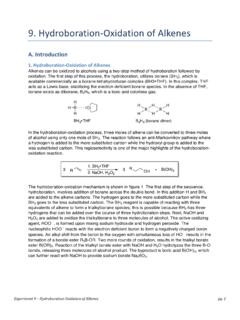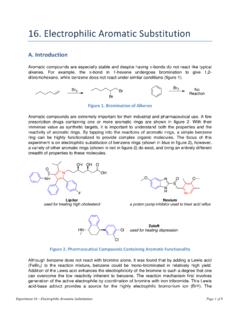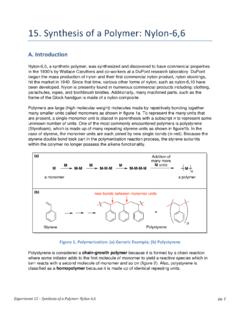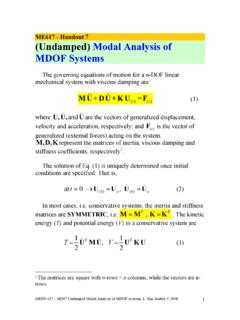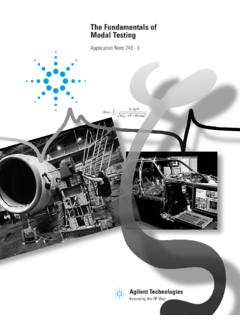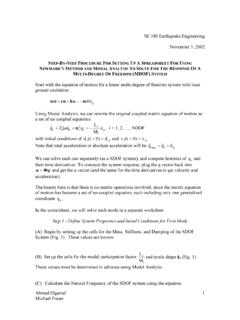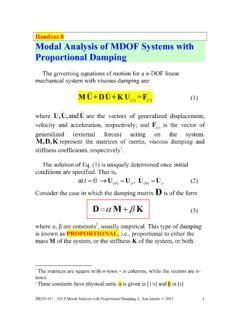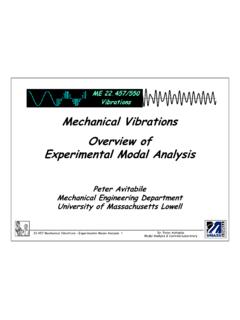Transcription of What we did on the computers last class Sec. 4.2-4
1 MAE 340 VibrationsModal AnalysisWhat we did on the computers last classSec. 340 Vibrations2 Free Vibration Solution In Sec. we solved the system differential matrix equation: by assuming: resulting in the equation: which was used to solve for natural frequencies: and mode shapes:MAE 340 Vibrations3 Eigenvalues and Eigenvectors In Linear Algebra, the Eigenvalue problem is: Given: Matrix A Matrix equation A v= v Find solutions for: A lot of knowledge is available in mathematics about Eigenvalue 340 Vibrations4 Mapping System Equation to Eigenvalue for Lsuch that M= L LT This can be done using a Cholesky decomposition This is like solving for the square-root of M.
2 Let s use M1/2 to refer to for inverse of L: M-1/2= inverse(L)MAE 340 Vibrations5 Mapping System Equation to Eigenvalue new function of time q(t) such that:q(t) = M x(t) or x(t) = M-1/2q(t) into system differential equation and pre-multiplying by M-1/2:MAE 340 Vibrations6 Mapping System Equation to Eigenvalue solution q(t) = vej t. Therefore:MAE 340 Vibrations7 Mapping System Equation to Eigenvalue problemTherefore, to map the system equation to an Eigenvalue problem: A=After solving for and v: ni= ui= MAE 340 Vibrations8 Mapping Eigenvalue problem to SDOF problem The Eigenvalues and Eigenvectors can be used to simplify a MDOF analysis into a several SDOF analyses:MAE 340 Vibrations9 Mapping Eigenvalue problem to SDOF problem Define matrix of eigenvectors:P= [ vn] Matrix of mode shapes is:S= [ un] = ____ P Define modal coordinates rsuch that.
3 Q(t) = P r(t)MAE 340 Vibrations10 Mapping Eigenvalue problem to SDOF problem Substituting P r(t) for q(t) in system equation and pre-multiplying by PTyields:MAE 340 Vibrations11 Mapping Eigenvalue problem to SDOF problem We therefore have a nice set of SDOF equations:MAE 340 Vibrations12 modal analysis To solve with initial conditions x(0) and x(0), use:r(0) = r(0) = To get back x(t) from r(t), use:x(t) = MAE 340 Vibrations13 modal analysis ProcedureComparing System Representations System 340 Vibrations14 Eigenvalue Prob. modal Problem + = Original Problem + = + = Form of sol. = = = After sub. = = is from = $%/ $%/ = $%/ = % 0 00 00 0 ( 0 = )$% 0 =) )= % * +MAE 340 Vibrations15 Nodes of a Mode These are places where the mode shape is zero.
4 Not a good place to mount a sensor or actuator for body motion. Good place to mount devices that shouldn t receive or transmit vibrations at the given natural 340 Vibrations16 Rigid-Body Modes Appear as natural frequencies with value of zero Require special treatment when evaluating motion from initial conditions (see p. 314 in text)MAE 340 Vibrations17 Viscous Damping It is relatively difficult to model individual dampers in a modal analysis . Some tricks are available: modal damping (apply damping ito system equation for each mode in modal coordinatesr(t)) Proportional damping (C= M+ K, with and chosen freely) MAE 340 Vibrations18 Forced ResponseForces can be mapped to modal
